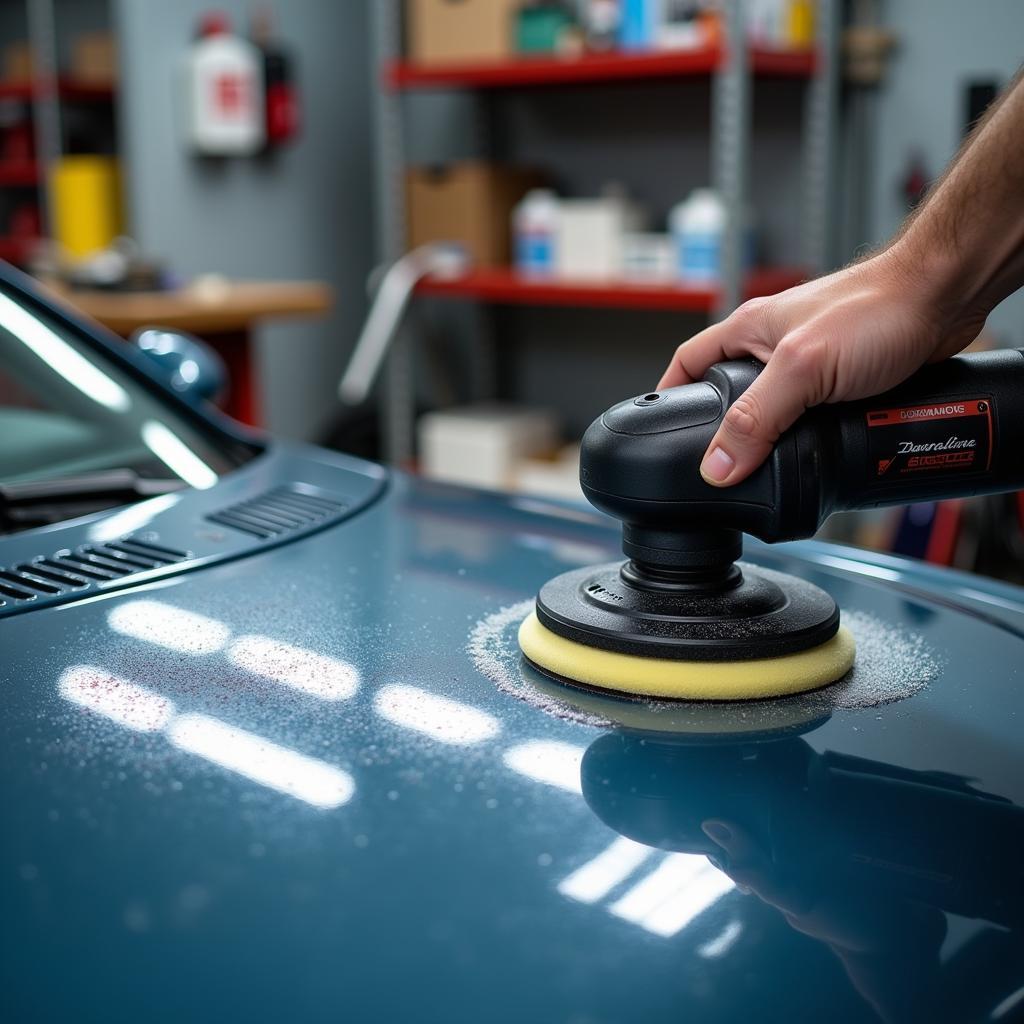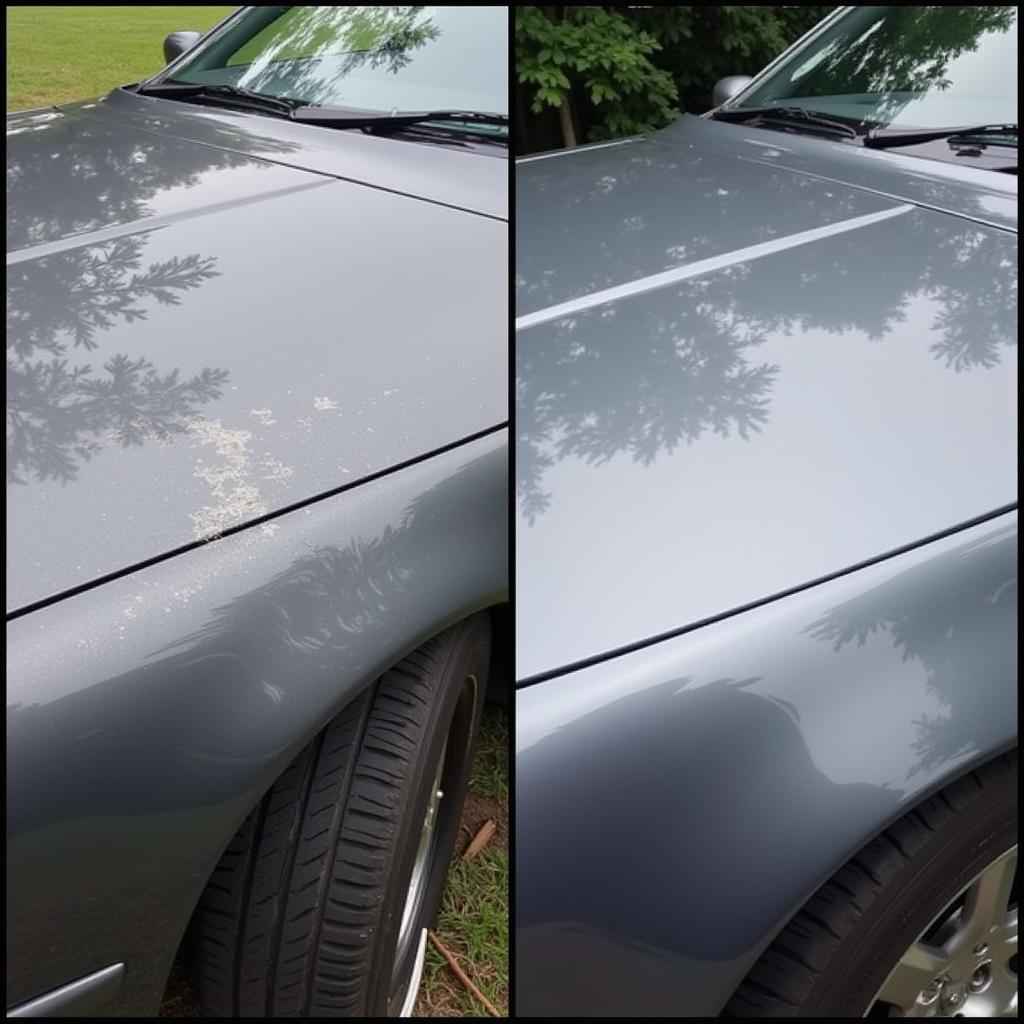Buffing, in the context of car detailing, is a crucial step that goes beyond a simple wash and wax. It involves using a specialized machine, typically a rotary or dual-action polisher, along with an abrasive compound or polish, to remove imperfections from the paint surface. These imperfections can include swirl marks, scratches, oxidation, and other blemishes that dull the car’s finish. Think of it as a meticulous exfoliation for your car’s paint, revealing the vibrant color underneath. Learning what buffing truly entails can be a game-changer for maintaining your car’s appearance. Interested in learning more about maintaining your car’s interior? Check out what do car detailers use to clean seats.
Understanding the Importance of Buffing
Why is buffing so important? Because it’s the key to restoring and enhancing your car’s paintwork. Over time, exposure to the elements, improper washing techniques, and even minor road debris can take a toll on your car’s paint, leaving it looking lackluster. Buffing effectively removes these imperfections, leaving a smooth, glossy finish. It preps the surface for waxing or sealant, ensuring a long-lasting shine. Buffing isn’t just about aesthetics; it also protects the paint from further damage.
Many car owners wonder about the differences between valeting and detailing. Find out more at what is the difference between car valeting and car detailing.
Types of Buffing Pads and Compounds
Choosing the right buffing pad and compound is crucial for achieving desired results. Buffing pads vary in aggressiveness, from heavy-cutting wool pads for removing deep scratches to softer foam pads for polishing and finishing. Compounds, too, come in different levels of abrasiveness, matching the pad and the severity of the paint imperfection. Using the wrong combination can lead to further damage, so understanding the differences is vital.
How to Choose the Right Buffing Pad and Compound
Selecting the right combination depends on the condition of the paint. For heavily swirled or scratched paint, a more aggressive wool pad and compound are necessary. For minor imperfections or simply enhancing the shine, a less aggressive foam pad and finer polish are suitable. Consulting with a professional detailer can help determine the best approach for your car’s specific needs.
 Car Buffing Process with Rotary Polisher
Car Buffing Process with Rotary Polisher
The Buffing Process: A Step-by-Step Guide
- Washing and Decontamination: Thoroughly wash and dry the car to remove any loose dirt and debris. Use a clay bar to remove embedded contaminants like iron particles and tree sap.
- Masking: Protect trim and plastic parts with masking tape to prevent accidental damage during buffing.
- Pad and Compound Selection: Choose the appropriate pad and compound based on the paint’s condition.
- Applying the Compound: Apply a small amount of compound to the buffing pad.
- Buffing: Work in small sections, applying even pressure and overlapping passes.
- Inspecting and Repeating: Inspect the buffed area and repeat the process if necessary.
- Wiping and Finishing: Wipe off any residue with a clean microfiber towel. Apply a wax or sealant for added protection and shine.
Want to try detailing your car yourself? Learn more about the necessary equipment at what equipment do car detailers use.
Common Mistakes to Avoid
- Using Excessive Pressure: Too much pressure can generate heat and damage the paint.
- Using the Wrong Pad or Compound: An incorrect combination can lead to scratches or swirl marks.
- Buffing in Direct Sunlight: This can cause the compound to dry too quickly and become difficult to remove.
- Not Cleaning the Buffing Pad Regularly: A dirty pad can introduce scratches and swirl marks.
 Car Paint Before and After Buffing
Car Paint Before and After Buffing
“Buffing is an art form,” says renowned detailing expert, David Miller, “and requires patience and attention to detail. Rushing the process can lead to disastrous results.”
The Benefits of Professional Buffing
While DIY buffing is possible, professional detailers possess the expertise, equipment, and experience to achieve optimal results. They can accurately assess the paint’s condition and select the appropriate techniques and products. Professional buffing ensures a flawless finish and protects your car’s paint for years to come. Curious about professional window cleaning techniques? Learn how do car detailers clean windows.
Are you interested in trying car detailing yourself? Check out how to detail my own car for a helpful guide.
Conclusion
Buffing is a vital step in car detailing that significantly enhances the appearance and protects the paintwork. Understanding what buffing means and the process involved allows car owners to make informed decisions about maintaining their vehicle’s finish. Whether choosing professional detailing or tackling a DIY project, buffing is a key element in achieving a show-stopping shine.
FAQ
- How often should I buff my car? Typically, buffing is recommended once or twice a year, depending on the car’s usage and environmental exposure.
- Can I buff my car by hand? Hand buffing is possible but less effective than machine buffing.
- What is the difference between buffing and polishing? Buffing typically refers to the process of removing imperfections, while polishing focuses on refining the finish and enhancing gloss.
- Is buffing safe for all paint types? Yes, but the correct pad and compound must be used for each specific paint type.
- How much does professional buffing cost? The cost varies depending on the car’s size and condition, but expect to pay between $100 and $300.
- Can buffing remove deep scratches? Deep scratches may require more aggressive techniques like wet sanding before buffing.
- What is the best way to maintain the shine after buffing? Regular washing and waxing will help preserve the shine after buffing.
“A well-buffed car is a reflection of the owner’s pride,” adds Sarah Johnson, a seasoned car detailer. “It’s not just about the shine, but the care and attention to detail that goes into achieving it.”
Looking for more information on car detailing? Explore other articles on our website related to car cleaning products, paint correction, and interior detailing techniques.
Need help with car detailing or have questions about our services? Contact us via WhatsApp: +1(641)206-8880 or Email: [email protected]. Our 24/7 customer support team is ready to assist you.

Leave a Reply